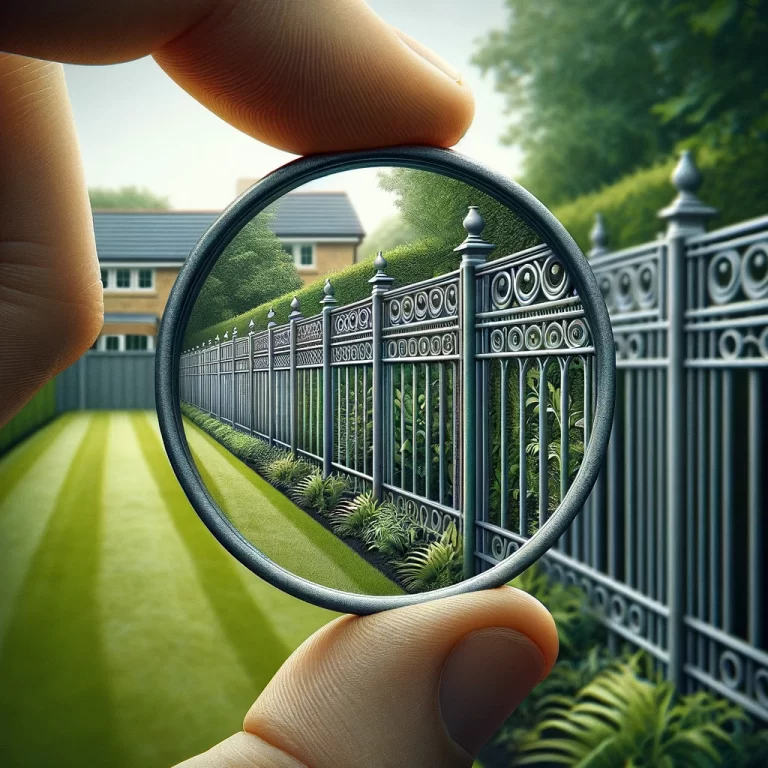Are you wondering about property boundaries and boundary fences in the UK? Confused about the rules and regulations surrounding boundary fences? In this article, we will explore everything you need to know about property boundaries, including the rules for boundary fences, permission requirements, height restrictions, materials allowed, and what to do if a neighbour puts up a fence without your permission. Stay tuned to learn how to protect your property boundary and resolve any disputes that may arise.

What Are Property Boundaries?
Property boundaries define the limits of a land area owned by an individual or entity, delineating where one property ends and another begins.
These boundaries play a crucial role in land ownership, providing clarity on property rights and responsibilities.
- Boundaries can take various forms such as natural features,
- fences, or man-made structures.
They not only establish ownership but also help prevent encroachment from neighbors and potential disputes. Maintaining these boundaries can be complex, with issues such as line-of-sight, maintenance, and accuracy of historical documents often causing disagreements. It is essential for property owners to maintain clear and precise boundaries to avoid potential conflicts and ensure peaceful coexistence with neighbors.
What Is a Boundary Fence?
A boundary fence is a physical structure that marks the division between two adjoining properties, serving as a visual and physical demarcation of land ownership.
For property owners, the installation of a boundary fence is not just about aesthetics; it plays a crucial role in establishing clear property limits and boundaries. The presence of a well-defined boundary fence helps to prevent disputes with neighbours regarding property lines, encroachments, or unauthorised use of land. By clearly outlining where one property ends and another begins, a boundary fence helps maintain privacy and security for both parties.
What Are the Rules for Boundary Fences in the UK?
Boundary fences in the UK are subject to specific rules and regulations governing their construction, maintenance, and resolution in case of disputes.
In the UK, the responsibility for maintaining and repairing a boundary fence is typically shared between neighbouring properties. It is essential to accurately determine the property boundaries before erecting or altering a fence.
According to the law, it is crucial for neighbours to reach an agreement on the maintenance and repair of the boundary fence. If a resolution cannot be reached, the involvement of surveyors may be necessary to determine the boundary lines and responsibilities. In cases where disputes escalate, the courts can intervene to provide a legal resolution.
Do I Need Permission to Put Up a Fence on My Property?
When considering erecting a fence on your property, it’s essential to determine whether you need specific permissions in compliance with legal regulations.
Installing a fence might seem like a straightforward task, but the legalities surrounding property boundaries and construction approvals can be complex. Failure to obtain the necessary permissions can lead to a range of issues, including fines, disputes with neighbours, or even having to remove the fence altogether. It’s important to understand that building without authorisation can have serious consequences, both in terms of legal implications and potential financial penalties.
Before starting any construction work, seeking approval from the local authorities or homeowner’s association is crucial. Different areas have varied regulations regarding the height, material, and location of fences, so it’s imperative to research and adhere to the specific requirements in your region.
How Tall Can a Boundary Fence Be?
The height limitations of a boundary fence are governed by legal regulations, ensuring that the structure complies with established standards while respecting property boundaries.
Boundary fence heights are generally subject to local rules, with many areas restricting the height to around 6 feet. Regulations can vary, so it’s crucial to check with the local planning department for specific guidelines in your area. Some areas may allow taller fences under certain circumstances, such as for security or privacy reasons, but these exceptions typically require special permits.
It’s important to note that exceeding the maximum height set by regulations can lead to legal consequences, including fines and possibly having to tear down the non-compliant structure. To avoid such issues, it’s advisable to work with a professional contractor who is familiar with the local laws and can ensure that your fence meets all height requirements.
What Materials Can Be Used for a Boundary Fence?
The choice of materials for a boundary fence is crucial, as it impacts the fence’s durability, appearance, and compliance with legal standards governing property boundaries.
When selecting fence materials, it’s vital to consider factors such as the local climate, maintenance requirements, and desired aesthetics. For example, wood offers a classic look but may require more upkeep than vinyl or composite materials. On the legal front, property owners should be aware of any regulations dictating the type of materials allowed, especially in shared boundary situations. Ensuring the chosen materials align with these legal requirements can prevent potential disputes with neighbours and authorities.

Can My Neighbour Put Up a Fence on My Boundary Without My Permission?
The legality of a neighbour putting up a fence on the boundary without permission hinges on property laws, boundary ownership, and potential dispute resolution mechanisms.
When facing such a situation, it is crucial to understand the laws governing property boundaries in your area. Property laws vary from place to place, with intricacies that can greatly impact boundary disputes.
- It’s advisable to check your property deed or land survey to determine the exact location of the boundary. This documentation can serve as crucial evidence if the dispute escalates to legal intervention.
Legal advice should be sought early on to navigate the complexities of property rights and resolve the conflict swiftly and amicably.
What Are the Steps to Resolve a Boundary Fence Dispute?
Resolving a boundary fence dispute involves a series of steps, including communication with the neighbour, seeking mediation, obtaining a surveyor’s report, and potentially resorting to legal action as a last resort.
Communication is the first crucial step in resolving any boundary fence disagreement. Express your concerns clearly but politely to the neighbour to open a constructive dialogue. If initial discussions prove challenging, suggest involving a mediator to facilitate negotiations and reach an amicable solution.
- Consulting a surveyor is another key component; their professional assessment can provide impartial evidence on boundary lines, material facts, and potential encroachments.
- Should all efforts fail, seeking legal recourse through the courts may be necessary, where a judge can make a final determination based on the evidence presented.
What Are the Consequences of Not Following Boundary Fence Rules?
Failure to adhere to boundary fence rules can result in various consequences such as legal repercussions, property disputes, financial liabilities, and damage to neighbourly relations.
When property owners neglect these regulations, they often find themselves entangled in complex legal battles, leading to hefty fines or even court injunctions. Property disputes arising from non-compliance can escalate quickly, resulting in costly legal proceedings and strained relationships with neighbours.
Financially, disregarding boundary fence rules can lead to unexpected expenses for repair or rebuilding of structures, not to mention potential compensation claims from affected parties.
The aftermath of breaching these rules extends beyond mere financial consequences, as it has the potential to disturb the peace and cooperation among neighbours, thereby tarnishing the overall community atmosphere.
What Are the Alternatives to a Boundary Fence?
In place of a traditional boundary fence, property owners can consider alternatives like boundary hedges or walls, offering distinct aesthetic and functional benefits for defining property borders.
Boundary hedges can create a natural barrier that enhances the overall landscape, providing privacy and security while also attracting wildlife. They come in various forms, from dense evergreen shrubs to colourful flowering plants, allowing owners to customise their property’s look.
On the other hand, walls offer durability and a more solid structure, ideal for noise reduction and increased boundary definition. Stone walls, for instance, add a touch of elegance and timeless appeal to any property.
Regulations regarding boundary hedges and walls differ, with some local authorities imposing height restrictions to ensure neighbourhood harmony. Proper maintenance, including trimming for hedges and occasional repairs for walls, is essential to preserve their functionality and appearance.
What Is a Boundary Hedge?
A boundary hedge is a natural barrier comprising dense vegetation like shrubs or trees, providing privacy, aesthetics, and ecological benefits while serving as a boundary marker between properties.
These green boundaries not only enhance the overall look of a property but also act as a natural sound barrier, reducing noise pollution from the surroundings. Beyond aesthetics, boundary hedges play a crucial role in supporting local wildlife by providing habitats for various bird species and small mammals. Hedges help in soil erosion prevention, especially in areas prone to heavy rainfall or wind. In terms of maintenance, regular trimming and pruning are essential to keep the hedge healthy and in shape.
Integration of traditional fence structures with a boundary hedge can create a striking visual appeal, combining the durability of fencing with the natural beauty of greenery. This fusion not only enhances security but also promotes biodiversity on the property. Consider incorporating trellises within the hedge to add vertical interest and support climbing plants, further enhancing the ecological benefits and aesthetic value of the boundary hedge.
What Is a Boundary Wall?
A boundary wall is a solid structure made of various materials such as brick, stone, or concrete, serving as a robust and permanent boundary feature for properties.
When considering the construction of a boundary wall, it is essential to assess the property’s needs and the surrounding environment. Factors such as the purpose of the wall, the desired aesthetics, and the local regulations must be taken into account.
The durability and maintenance requirements of the materials used play a crucial role in determining the longevity of the boundary wall. Proper foundations and structural stability are also critical aspects to ensure the wall’s strength and longevity.
From a legal perspective, property boundaries defined by walls need to adhere to specific regulations to avoid disputes with neighbors. The construction of boundary walls may require permits or approvals, depending on the location and height of the wall, to ensure compliance with local building codes.
How Can I Protect My Property Boundary?
Protecting your property boundary involves understanding ownership rights, legal regulations, and registering precise boundary details with the Land Registry to safeguard against potential disputes.
Knowing who owns what and where, within the confines of your property, is fundamental not just for peace of mind but also to adhere to the law. Ownership disputes can quickly escalate into costly legal battles, making it crucial to have clear and documented boundaries.
By ensuring your property’s boundaries are accurately delineated and registered with the Land Registry, you establish a legal framework that protects your interests and minimises the risk of boundary disagreements with neighbours.
Can I Get Legal Help for Boundary Fence Disputes?
Seeking legal assistance for boundary fence disputes can provide guidance on navigating complex legal frameworks, negotiating with neighbours, and representing your interests in court if necessary.
Understanding the benefits of seeking professional help in resolving boundary fence conflicts can make a significant difference in the outcome. Solicitors specialising in property law can offer valuable advice on rights, responsibilities, and possible solutions. Involving the court system under the guidance of a solicitor can streamline the resolution process and ensure a fair outcome. Legal procedures provide a structured approach to resolving disputes, offering clarity and enforceability. Accessing expert assistance can help in achieving amicable resolutions and safeguarding your property interests.






